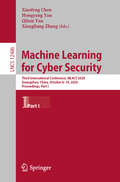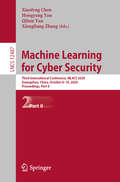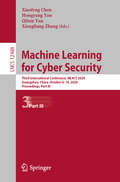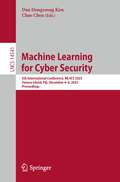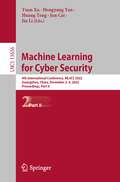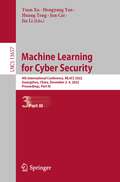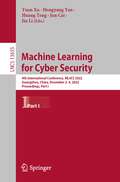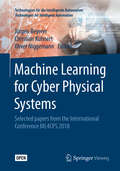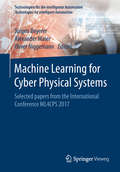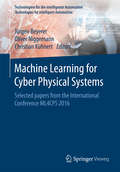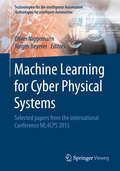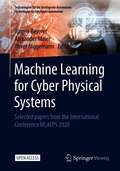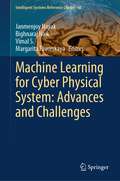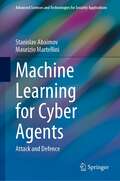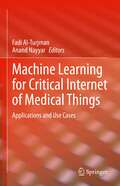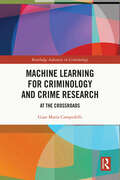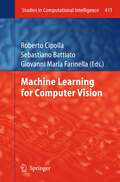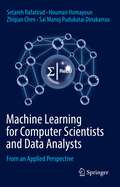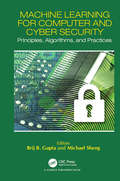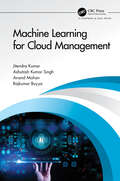- Table View
- List View
Machine Learning for Data Mining: Improve Your Data Mining Capabilities With Advanced Predictive Modeling
by Jose Jesus SalcedoMost data mining opportunities involve machine learning and often come with greater financial rewards. This book will help you bring the power of machine learning techniques into your data mining work. By the end of the book, you will be able to create accurate predictive models for data mining.
Machine Learning for Cyber Security: Second International Conference, ML4CS 2019, Xi’an, China, September 19-21, 2019, Proceedings (Lecture Notes in Computer Science #11806)
by Xiaofeng Chen Xinyi Huang Jun ZhangThis book constitutes the proceedings of the Second International Conference on Machine Learning for Cyber Security, ML4CS 2019, held in Xi’an, China in September 2019. The 23 revised full papers and 3 short papers presented were carefully reviewed and selected from 70 submissions. The papers detail all aspects of machine learning in network infrastructure security, in network security detections and in application software security.
Machine Learning for Cyber Security: Third International Conference, ML4CS 2020, Guangzhou, China, October 8–10, 2020, Proceedings, Part I (Lecture Notes in Computer Science #12486)
by Xiaofeng Chen Hongyang Yan Qiben Yan Xiangliang ZhangThis three volume book set constitutes the proceedings of the Third International Conference on Machine Learning for Cyber Security, ML4CS 2020, held in Xi’an, China in October 2020.The 118 full papers and 40 short papers presented were carefully reviewed and selected from 360 submissions. The papers offer a wide range of the following subjects: Machine learning, security, privacy-preserving, cyber security, Adversarial machine Learning, Malware detection and analysis, Data mining, and Artificial Intelligence.
Machine Learning for Cyber Security: Third International Conference, ML4CS 2020, Guangzhou, China, October 8–10, 2020, Proceedings, Part II (Lecture Notes in Computer Science #12487)
by Xiaofeng Chen Hongyang Yan Qiben Yan Xiangliang ZhangThis three volume book set constitutes the proceedings of the Third International Conference on Machine Learning for Cyber Security, ML4CS 2020, held in Xi’an, China in October 2020.The 118 full papers and 40 short papers presented were carefully reviewed and selected from 360 submissions. The papers offer a wide range of the following subjects: Machine learning, security, privacy-preserving, cyber security, Adversarial machine Learning, Malware detection and analysis, Data mining, and Artificial Intelligence.
Machine Learning for Cyber Security: Third International Conference, ML4CS 2020, Guangzhou, China, October 8–10, 2020, Proceedings, Part III (Lecture Notes in Computer Science #12488)
by Xiaofeng Chen Hongyang Yan Qiben Yan Xiangliang ZhangThis three volume book set constitutes the proceedings of the Third International Conference on Machine Learning for Cyber Security, ML4CS 2020, held in Xi’an, China in October 2020.The 118 full papers and 40 short papers presented were carefully reviewed and selected from 360 submissions. The papers offer a wide range of the following subjects: Machine learning, security, privacy-preserving, cyber security, Adversarial machine Learning, Malware detection and analysis, Data mining, and Artificial Intelligence.
Machine Learning for Cyber Security: 5th International Conference, ML4CS 2023, Yanuca Island, Fiji, December 4–6, 2023, Proceedings (Lecture Notes in Computer Science #14541)
by Dan Dongseong Kim Chao ChenThis book constitutes the referred proceedings of the 5th International Conference on Machine Learning for Cyber Security, ML4CS 2023, held in Yanuca Island, Fiji, during December 4–6, 2023. The 11 full papers presented in this book were carefully reviewed and selected from 35 submissions. They cover a variety of topics, including cybersecurity, AI security, machine learning security, encryption, authentication, data security and privacy, cybersecurity forensic analysis, vulnerability analysis, malware analysis, anomaly and intrusion detection.
Machine Learning for Cyber Security: 4th International Conference, ML4CS 2022, Guangzhou, China, December 2–4, 2022, Proceedings, Part II (Lecture Notes in Computer Science #13656)
by Yuan Xu Hongyang Yan Huang Teng Jun Cai Jin LiThe three-volume proceedings set LNCS 13655,13656 and 13657 constitutes the refereedproceedings of the 4th International Conference on Machine Learning for Cyber Security, ML4CS 2022, which taking place during December 2–4, 2022, held in Guangzhou, China. The 100 full papers and 46 short papers were included in these proceedings were carefully reviewed and selected from 367 submissions.
Machine Learning for Cyber Security: 4th International Conference, ML4CS 2022, Guangzhou, China, December 2–4, 2022, Proceedings, Part III (Lecture Notes in Computer Science #13657)
by Yuan Xu Hongyang Yan Huang Teng Jun Cai Jin LiThe three-volume proceedings set LNCS 13655,13656 and 13657 constitutes the refereedproceedings of the 4th International Conference on Machine Learning for Cyber Security, ML4CS 2022, which taking place during December 2–4, 2022, held in Guangzhou, China.The 100 full papers and 46 short papers were included in these proceedings were carefully reviewed and selected from 367 submissions.
Machine Learning for Cyber Security: 4th International Conference, ML4CS 2022, Guangzhou, China, December 2–4, 2022, Proceedings, Part I (Lecture Notes in Computer Science #13655)
by Yuan Xu Hongyang Yan Huang Teng Jun Cai Jin LiThe three-volume proceedings set LNCS 13655,13656 and 13657 constitutes the refereedproceedings of the 4th International Conference on Machine Learning for Cyber Security, ML4CS 2022, which taking place during December 2–4, 2022, held in Guangzhou, China.The 100 full papers and 46 short papers were included in these proceedings were carefully reviewed and selected from 367 submissions.
Machine Learning for Cyber Physical Systems
by Jürgen Beyerer Christian Kühnert Oliver NiggemannThis Open Access proceedings presents new approaches to Machine Learning for Cyber Physical Systems, experiences and visions. It contains some selected papers from the international Conference ML4CPS – Machine Learning for Cyber Physical Systems, which was held in Karlsruhe, October 23-24, 2018. Cyber Physical Systems are characterized by their ability to adapt and to learn: They analyze their environment and, based on observations, they learn patterns, correlations and predictive models. Typical applications are condition monitoring, predictive maintenance, image processing and diagnosis. Machine Learning is the key technology for these developments.
Machine Learning for Cyber Physical Systems: Selected papers from the International Conference ML4CPS 2017 (Technologien für die intelligente Automation #11)
by Jürgen Beyerer Alexander Maier Oliver NiggemannThe work presents new approaches to Machine Learning for Cyber Physical Systems, experiences and visions. It contains some selected papers from the international Conference ML4CPS – Machine Learning for Cyber Physical Systems, which was held in Lemgo, October 25th-26th, 2017. Cyber Physical Systems are characterized by their ability to adapt and to learn: They analyze their environment and, based on observations, they learn patterns, correlations and predictive models. Typical applications are condition monitoring, predictive maintenance, image processing and diagnosis. Machine Learning is the key technology for these developments.
Machine Learning for Cyber Physical Systems: Selected papers from the International Conference ML4CPS 2016 (Technologien für die intelligente Automation)
by Jürgen Beyerer Oliver Niggemann Christian KühnertThe work presents new approaches to Machine Learning for Cyber Physical Systems, experiences and visions. It contains some selected papers from the international Conference ML4CPS – Machine Learning for Cyber Physical Systems, which was held in Karlsruhe, September 29th, 2016. Cyber Physical Systems are characterized by their ability to adapt and to learn: They analyze their environment and, based on observations, they learn patterns, correlations and predictive models. Typical applications are condition monitoring, predictive maintenance, image processing and diagnosis. Machine Learning is the key technology for these developments.
Machine Learning for Cyber Physical Systems: Selected papers from the International Conference ML4CPS 2015 (Technologien für die intelligente Automation #0)
by Oliver Niggemann Jürgen BeyererThe work presents new approaches to Machine Learning for Cyber Physical Systems, experiences and visions. It contains some selected papers from the international Conference ML4CPS – Machine Learning for Cyber Physical Systems, which was held in Lemgo, October 1-2, 2015. Cyber Physical Systems are characterized by their ability to adapt and to learn: They analyze their environment and, based on observations, they learn patterns, correlations and predictive models. Typical applications are condition monitoring, predictive maintenance, image processing and diagnosis. Machine Learning is the key technology for these developments.
Machine Learning for Cyber Physical Systems: Selected papers from the International Conference ML4CPS 2020 (Technologien für die intelligente Automation #13)
This open access proceedings presents new approaches to Machine Learning for Cyber Physical Systems, experiences and visions. It contains selected papers from the fifth international Conference ML4CPS – Machine Learning for Cyber Physical Systems, which was held in Berlin, March 12-13, 2020. Cyber Physical Systems are characterized by their ability to adapt and to learn: They analyze their environment and, based on observations, they learn patterns, correlations and predictive models. Typical applications are condition monitoring, predictive maintenance, image processing and diagnosis. Machine Learning is the key technology for these developments.
Machine Learning for Cyber Physical System: Advances and Challenges (Intelligent Systems Reference Library #60)
by Janmenjoy Nayak Bighnaraj Naik Vimal S. Margarita FavorskayaThis book provides a comprehensive platform for learning the state-of-the-art machine learning algorithms for solving several cybersecurity issues. It is helpful in guiding for the implementation of smart machine learning solutions to detect various cybersecurity problems and make the users to understand in combating malware, detect spam, and fight financial fraud to mitigate cybercrimes. With an effective analysis of cyber-physical data, it consists of the solution for many real-life problems such as anomaly detection, IoT-based framework for security and control, manufacturing control system, fault detection, smart cities, risk assessment of cyber-physical systems, medical diagnosis, smart grid systems, biometric-based physical and cybersecurity systems using advance machine learning approach. Filling an important gap between machine learning and cybersecurity communities, it discusses topics covering a wide range of modern and practical advance machine learning techniques, frameworks, and development tools to enable readers to engage with the cutting-edge research across various aspects of cybersecurity.
Machine Learning for Cyber Agents: Attack and Defence (Advanced Sciences and Technologies for Security Applications)
by Maurizio Martellini Stanislav AbaimovThe cyber world has been both enhanced and endangered by AI. On the one hand, the performance of many existing security services has been improved, and new tools created. On the other, it entails new cyber threats both through evolved attacking capacities and through its own imperfections and vulnerabilities. Moreover, quantum computers are further pushing the boundaries of what is possible, by making machine learning cyber agents faster and smarter. With the abundance of often-confusing information and lack of trust in the diverse applications of AI-based technologies, it is essential to have a book that can explain, from a cyber security standpoint, why and at what stage the emerging, powerful technology of machine learning can and should be mistrusted, and how to benefit from it while avoiding potentially disastrous consequences. In addition, this book sheds light on another highly sensitive area – the application of machine learning for offensive purposes, an aspect that is widely misunderstood, under-represented in the academic literature and requires immediate expert attention.
Machine Learning for Critical Internet of Medical Things: Applications and Use Cases
by Fadi Al-Turjman Anand NayyarThis book discusses the applications, challenges, and future trends of machine learning in medical domain, including both basic and advanced topics. The book presents how machine learning is helpful in smooth conduction of administrative processes in hospitals, in treating infectious diseases, and in personalized medical treatments. The authors show how machine learning can also help make fast and more accurate disease diagnoses, easily identify patients, help in new types of therapies or treatments, model small-molecule drugs in pharmaceutical sector, and help with innovations via integrated technologies such as artificial intelligence as well as deep learning. The authors show how machine learning also improves the physician’s and doctor’s medical capabilities to better diagnosis their patients. This book illustrates advanced, innovative techniques, frameworks, concepts, and methodologies of machine learning that will enhance the efficiency and effectiveness of the healthcare system.Provides researchers in machine and deep learning with a conceptual understanding of various methodologies of implementing the technologies in medical areas;Discusses the role machine learning and IoT play into locating different virus and diseases across the globe, such as COVID-19, Ebola, and cervical cancer;Includes fundamentals and advances in machine learning in the medical field, supported by significant case studies and practical applications.
Machine Learning for Criminology and Crime Research: At the Crossroads (Routledge Advances in Criminology)
by Gian Maria CampedelliMachine Learning for Criminology and Crime Research: At the Crossroads reviews the roots of the intersection between machine learning, artificial intelligence (AI), and research on crime; examines the current state of the art in this area of scholarly inquiry; and discusses future perspectives that may emerge from this relationship. As machine learning and AI approaches become increasingly pervasive, it is critical for criminology and crime research to reflect on the ways in which these paradigms could reshape the study of crime. In response, this book seeks to stimulate this discussion. The opening part is framed through a historical lens, with the first chapter dedicated to the origins of the relationship between AI and research on crime, refuting the "novelty narrative" that often surrounds this debate. The second presents a compact overview of the history of AI, further providing a nontechnical primer on machine learning. The following chapter reviews some of the most important trends in computational criminology and quantitatively characterizing publication patterns at the intersection of AI and criminology, through a network science approach. This book also looks to the future, proposing two goals and four pathways to increase the positive societal impact of algorithmic systems in research on crime. The sixth chapter provides a survey of the methods emerging from the integration of machine learning and causal inference, showcasing their promise for answering a range of critical questions. With its transdisciplinary approach, Machine Learning for Criminology and Crime Research is important reading for scholars and students in criminology, criminal justice, sociology, and economics, as well as AI, data sciences and statistics, and computer science.
Machine Learning for Criminology and Crime Research: At the Crossroads (Routledge Advances in Criminology)
by Gian Maria CampedelliMachine Learning for Criminology and Crime Research: At the Crossroads reviews the roots of the intersection between machine learning, artificial intelligence (AI), and research on crime; examines the current state of the art in this area of scholarly inquiry; and discusses future perspectives that may emerge from this relationship. As machine learning and AI approaches become increasingly pervasive, it is critical for criminology and crime research to reflect on the ways in which these paradigms could reshape the study of crime. In response, this book seeks to stimulate this discussion. The opening part is framed through a historical lens, with the first chapter dedicated to the origins of the relationship between AI and research on crime, refuting the "novelty narrative" that often surrounds this debate. The second presents a compact overview of the history of AI, further providing a nontechnical primer on machine learning. The following chapter reviews some of the most important trends in computational criminology and quantitatively characterizing publication patterns at the intersection of AI and criminology, through a network science approach. This book also looks to the future, proposing two goals and four pathways to increase the positive societal impact of algorithmic systems in research on crime. The sixth chapter provides a survey of the methods emerging from the integration of machine learning and causal inference, showcasing their promise for answering a range of critical questions. With its transdisciplinary approach, Machine Learning for Criminology and Crime Research is important reading for scholars and students in criminology, criminal justice, sociology, and economics, as well as AI, data sciences and statistics, and computer science.
Machine Learning for Computer Vision (Studies in Computational Intelligence #411)
by Roberto Cipolla Sebastiano Battiato Giovanni Maria FarinellaComputer vision is the science and technology of making machines that see. It is concerned with the theory, design and implementation of algorithms that can automatically process visual data to recognize objects, track and recover their shape and spatial layout. The International Computer Vision Summer School - ICVSS was established in 2007 to provide both an objective and clear overview and an in-depth analysis of the state-of-the-art research in Computer Vision. The courses are delivered by world renowned experts in the field, from both academia and industry, and cover both theoretical and practical aspects of real Computer Vision problems. The school is organized every year by University of Cambridge (Computer Vision and Robotics Group) and University of Catania (Image Processing Lab). Different topics are covered each year. A summary of the past Computer Vision Summer Schools can be found at: http://www.dmi.unict.it/icvss This edited volume contains a selection of articles covering some of the talks and tutorials held during the last editions of the school. The chapters provide an in-depth overview of challenging areas with key references to the existing literature.
Machine Learning for Computer Scientists and Data Analysts: From an Applied Perspective
by Setareh Rafatirad Houman Homayoun Zhiqian Chen Sai Manoj Pudukotai DinakarraoThis textbook introduces readers to the theoretical aspects of machine learning (ML) algorithms, starting from simple neuron basics, through complex neural networks, including generative adversarial neural networks and graph convolution networks. Most importantly, this book helps readers to understand the concepts of ML algorithms and enables them to develop the skills necessary to choose an apt ML algorithm for a problem they wish to solve. In addition, this book includes numerous case studies, ranging from simple time-series forecasting to object recognition and recommender systems using massive databases. Lastly, this book also provides practical implementation examples and assignments for the readers to practice and improve their programming capabilities for the ML applications.
Machine Learning for Computer and Cyber Security: Principle, Algorithms, and Practices (Cyber Ecosystem and Security)
by Brij B. Gupta Michael ShengWhile Computer Security is a broader term which incorporates technologies, protocols, standards and policies to ensure the security of the computing systems including the computer hardware, software and the information stored in it, Cyber Security is a specific, growing field to protect computer networks (offline and online) from unauthorized access, botnets, phishing scams, etc. Machine learning is a branch of Computer Science which enables computing machines to adopt new behaviors on the basis of observable and verifiable data and information. It can be applied to ensure the security of the computers and the information by detecting anomalies using data mining and other such techniques. This book will be an invaluable resource to understand the importance of machine learning and data mining in establishing computer and cyber security. It emphasizes important security aspects associated with computer and cyber security along with the analysis of machine learning and data mining based solutions. The book also highlights the future research domains in which these solutions can be applied. Furthermore, it caters to the needs of IT professionals, researchers, faculty members, scientists, graduate students, research scholars and software developers who seek to carry out research and develop combating solutions in the area of cyber security using machine learning based approaches. It is an extensive source of information for the readers belonging to the field of Computer Science and Engineering, and Cyber Security professionals. Key Features: This book contains examples and illustrations to demonstrate the principles, algorithms, challenges and applications of machine learning and data mining for computer and cyber security. It showcases important security aspects and current trends in the field. It provides an insight of the future research directions in the field. Contents of this book help to prepare the students for exercising better defense in terms of understanding the motivation of the attackers and how to deal with and mitigate the situation using machine learning based approaches in better manner.
Machine Learning for Computer and Cyber Security: Principle, Algorithms, and Practices (Cyber Ecosystem and Security)
by Brij B. Gupta Quan Z. ShengWhile Computer Security is a broader term which incorporates technologies, protocols, standards and policies to ensure the security of the computing systems including the computer hardware, software and the information stored in it, Cyber Security is a specific, growing field to protect computer networks (offline and online) from unauthorized access, botnets, phishing scams, etc. Machine learning is a branch of Computer Science which enables computing machines to adopt new behaviors on the basis of observable and verifiable data and information. It can be applied to ensure the security of the computers and the information by detecting anomalies using data mining and other such techniques. This book will be an invaluable resource to understand the importance of machine learning and data mining in establishing computer and cyber security. It emphasizes important security aspects associated with computer and cyber security along with the analysis of machine learning and data mining based solutions. The book also highlights the future research domains in which these solutions can be applied. Furthermore, it caters to the needs of IT professionals, researchers, faculty members, scientists, graduate students, research scholars and software developers who seek to carry out research and develop combating solutions in the area of cyber security using machine learning based approaches. It is an extensive source of information for the readers belonging to the field of Computer Science and Engineering, and Cyber Security professionals. Key Features: This book contains examples and illustrations to demonstrate the principles, algorithms, challenges and applications of machine learning and data mining for computer and cyber security. It showcases important security aspects and current trends in the field. It provides an insight of the future research directions in the field. Contents of this book help to prepare the students for exercising better defense in terms of understanding the motivation of the attackers and how to deal with and mitigate the situation using machine learning based approaches in better manner.
Machine Learning for Cloud Management
by Jitendra Kumar Ashutosh Kumar Singh Anand Mohan Rajkumar BuyyaCloud computing offers subscription-based on-demand services, and it has emerged as the backbone of the computing industry. It has enabled us to share resources among multiple users through virtualization, which creates a virtual instance of a computer system running in an abstracted hardware layer. Unlike early distributed computing models, it offers virtually limitless computing resources through its large scale cloud data centers. It has gained wide popularity over the past few years, with an ever-increasing infrastructure, a number of users, and the amount of hosted data. The large and complex workloads hosted on these data centers introduce many challenges, including resource utilization, power consumption, scalability, and operational cost. Therefore, an effective resource management scheme is essential to achieve operational efficiency with improved elasticity. Machine learning enabled solutions are the best fit to address these issues as they can analyze and learn from the data. Moreover, it brings automation to the solutions, which is an essential factor in dealing with large distributed systems in the cloud paradigm. Machine Learning for Cloud Management explores cloud resource management through predictive modelling and virtual machine placement. The predictive approaches are developed using regression-based time series analysis and neural network models. The neural network-based models are primarily trained using evolutionary algorithms, and efficient virtual machine placement schemes are developed using multi-objective genetic algorithms. Key Features: The first book to set out a range of machine learning methods for efficient resource management in a large distributed network of clouds. Predictive analytics is an integral part of efficient cloud resource management, and this book gives a future research direction to researchers in this domain. It is written by leading international researchers. The book is ideal for researchers who are working in the domain of cloud computing.
Machine Learning for Cloud Management
by Jitendra Kumar Ashutosh Kumar Singh Anand Mohan Rajkumar BuyyaCloud computing offers subscription-based on-demand services, and it has emerged as the backbone of the computing industry. It has enabled us to share resources among multiple users through virtualization, which creates a virtual instance of a computer system running in an abstracted hardware layer. Unlike early distributed computing models, it offers virtually limitless computing resources through its large scale cloud data centers. It has gained wide popularity over the past few years, with an ever-increasing infrastructure, a number of users, and the amount of hosted data. The large and complex workloads hosted on these data centers introduce many challenges, including resource utilization, power consumption, scalability, and operational cost. Therefore, an effective resource management scheme is essential to achieve operational efficiency with improved elasticity. Machine learning enabled solutions are the best fit to address these issues as they can analyze and learn from the data. Moreover, it brings automation to the solutions, which is an essential factor in dealing with large distributed systems in the cloud paradigm. Machine Learning for Cloud Management explores cloud resource management through predictive modelling and virtual machine placement. The predictive approaches are developed using regression-based time series analysis and neural network models. The neural network-based models are primarily trained using evolutionary algorithms, and efficient virtual machine placement schemes are developed using multi-objective genetic algorithms. Key Features: The first book to set out a range of machine learning methods for efficient resource management in a large distributed network of clouds. Predictive analytics is an integral part of efficient cloud resource management, and this book gives a future research direction to researchers in this domain. It is written by leading international researchers. The book is ideal for researchers who are working in the domain of cloud computing.


